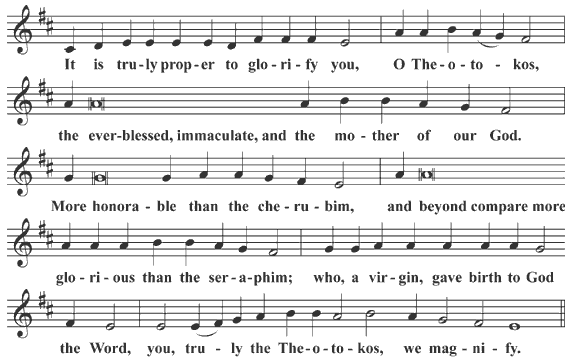Singing the Anaphora of St. John Chrysostom
The Anaphora of St. John Chrysostom is the central part of the Divine Liturgy of the same name. This article explains how to sing the responses for this Anaphora, and covers pages 55-63 of our Divine Liturgies book.
The introductory dialog
The first response to the introductory dialog before the anaphora is a trumpet-like call to prayer, going all the way up to sol:
The remaining responses all follow the Long Amen pattern:
These should be sung solemnly and with care, but not particularly slowly
The Hymn of Victory - Holy, Holy, Holy
After the words, "Singing, shouting, crying aloud, and saying the triumphal hymn:", the people sing the hymn "Holy, Holy, Holy", which combines Isaiah's vision of the cherubim and seraphim before God's throne, with a psalm verse in praise of Christ. The Divine Liturgies book contains three settings of this hymn.
Holy, Holy, Holy A
The A setting of the Hymn of Victory is found on pages 56 of the Divine Liturgies book.Like the Trisagion and Cherubic Hymn, the Hymn of Victory should be sung "straight through", without noticeable gaps or pauses between the phrases.
As usual, make sure you can identify the key signature, find the tonic pitch or do, and identify the solfege syllables for the first three or four notes.
Holy, Holy, Holy B
The B setting of the Hymn of Victory is found on pages 56-57 of the Divine Liturgies book.Holy, Holy, Holy C
The C setting of the Hymn of Victory is found on page 57 of the Divine Liturgies book.The Anamnesis: "We praise you, we bless you"
The "Amen" responses at our Lord's words over the bread and wine use the short Amen melody. This should be sung clearly and solemnly, while remembering that in our tradition, it is the entire prayer which consecrates the bread and wine, and not solely these words.
There are many settings of the acclamation that concludes the anamnesis section of the Anaphora: "We praise you, we bless you, we thank you, O Lord." The Divine Liturgies book provides one setting for each Cherubikon or Cherubic Hymn melody, and one extra setting that may be used as desired, labelled H:
Prayers for those who have died: "It is truly proper"
During the prayers for those who have died, the priest prays "especially" for the Mother of God, and the faithful interrupt with a hymn in her honor, from the Octoechos or book of Eight Tones. The Divine Liturgies book provides a single setting of this hymn (DL 62), using the Tone 6 samohlasen melody.
On feast-days, the magnification and irmos from the Matins canon of the feastday are sung in place of this hymn.
Prayers for the living
The people conclude the prayers for the living with their own response:
The conclusion of the Anaphora
The entire Anaphora is concluded with a single Amen. This uses the short melody (since it does not "cover" any liturgical action on the part of the priest), but it should be sung broadly, solemnly, and well, as befits the importance of the prayer that it concludes:












